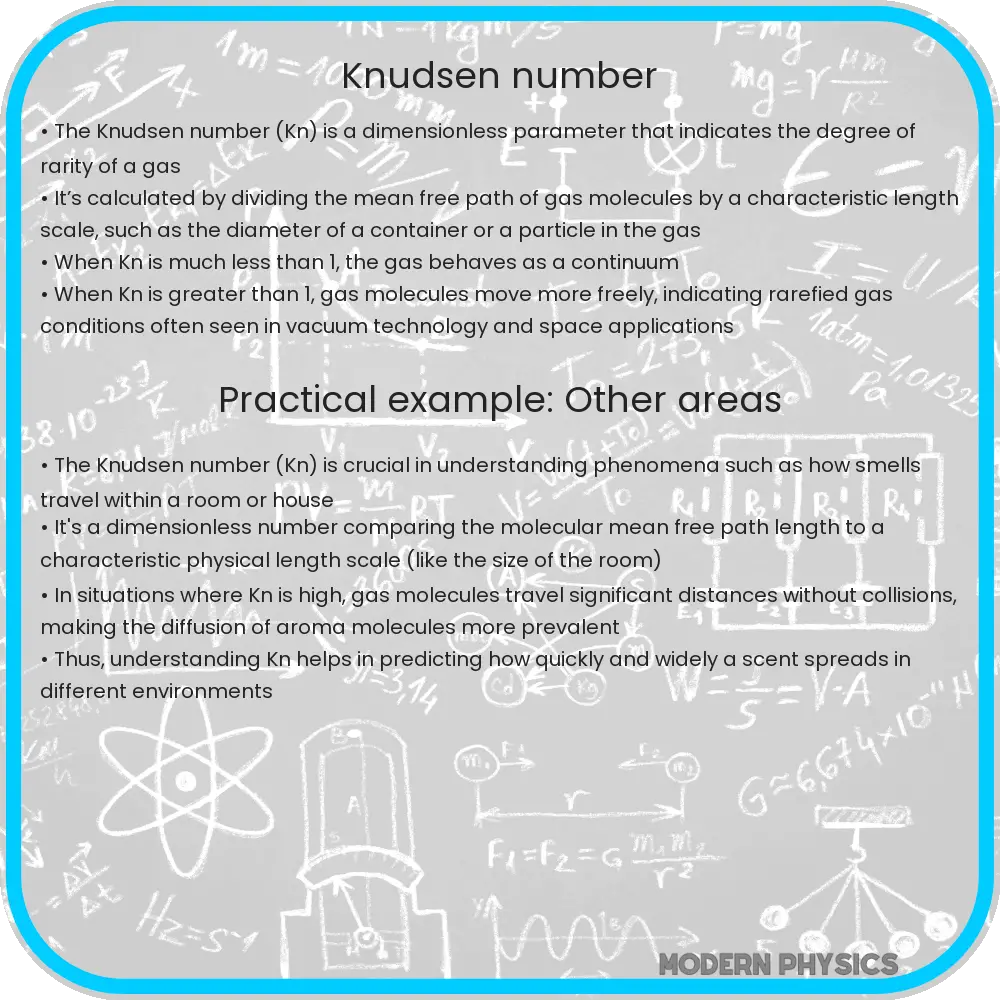Explore the Knudsen Number in fluid mechanics: its definition, significance, and applications in engineering, aerospace, and microfluidics.

Understanding the Knudsen Number in Fluid Mechanics
The Knudsen Number (Kn), a dimensionless parameter, is pivotal in the field of fluid mechanics, especially in the analysis of gas flows. It is defined as the ratio of the mean free path length of a gas molecule (λ) to a characteristic physical length scale (L), such as the diameter of a pipe or a channel. Mathematically, it is expressed as:
Kn = λ / L
Significance and Application of the Knudsen Number
The importance of the Knudsen Number lies in its ability to characterize the nature of a gas flow. Depending on its value, different flow regimes can be identified:
- Continuum Flow: When Kn < 0.01, the flow is in the continuum regime. In this case, the gas can be treated as a continuous medium, and traditional fluid dynamics principles, such as Navier-Stokes equations, are applicable.
- Slip Flow: For 0.01 ≤ Kn < 0.1, the flow enters the slip flow regime. Here, the gas begins to exhibit non-continuum effects, and modifications to the standard fluid dynamics equations are required.
- Transition Flow: In the range of 0.1 ≤ Kn ≤ 10, the flow is in the transition regime. Neither continuum nor free molecular flow models are adequate, and more complex analysis techniques are needed.
- Free Molecular Flow: When Kn > 10, the flow is in the free molecular regime. Gas molecules move more independently of each other, and molecular dynamics become significant.
This classification is crucial in many engineering applications, such as aerospace engineering, where high altitudes result in low air density and large Knudsen numbers, and in microfluidics, where the small dimensions of channels can lead to higher Knudsen numbers even at standard atmospheric conditions.
Analytical Approaches Based on Knudsen Number
In engineering and scientific applications, accurately predicting the behavior of gas flows under varying Knudsen numbers is essential. For continuum flows, traditional computational fluid dynamics (CFD) methods are used. However, as Kn increases, modifications to these models, such as introducing slip boundary conditions or using the Burnett equations, become necessary. For high Kn values, in the transition and free molecular regimes, direct simulation Monte Carlo (DSMC) methods or molecular dynamics simulations are often employed. These methods account for the individual behavior of gas molecules, providing more accurate results in rarefied gas conditions.
Challenges and Recent Advances in Knudsen Number Analysis
Understanding and predicting the behavior of gases across different Knudsen number regimes pose significant challenges. In the slip and transition flow regimes, where neither continuum nor purely molecular approaches are completely valid, hybrid methods are often employed. These methods combine elements of both continuum mechanics and molecular dynamics to provide a more accurate representation of the flow. Advanced computational techniques, such as Lattice Boltzmann methods, are also being explored for their potential to bridge the gap between different flow regimes.
Practical Implications of Knudsen Number in Industry and Research
The concept of the Knudsen number has practical implications in various fields. In semiconductor manufacturing, for example, understanding gas flow at the microscale is crucial for deposition and etching processes. Similarly, in vacuum technology and space applications, where high Knudsen numbers are common, accurately predicting gas behavior is vital for the design of thrusters and environmental control systems. Furthermore, in biomedical engineering, the study of respiratory flows requires a detailed understanding of gas dynamics at different Knudsen numbers.
In environmental science, the Knudsen number aids in understanding atmospheric phenomena, especially at high altitudes where traditional fluid dynamics may not apply. The analysis of gas flows in porous media, significant in geology and petroleum engineering, also leverages the concept of the Knudsen number for more precise modeling.
Conclusion
The Knudsen number is a fundamental concept in fluid mechanics, offering a comprehensive way to categorize gas flow regimes based on the relationship between molecular mean free path and characteristic physical dimensions. Its applicability ranges from aerospace engineering to microfluidics, impacting both theoretical research and practical applications. As technology advances, especially in the fields of micro and nanotechnology, the significance of the Knudsen number is ever-increasing, demanding more sophisticated and accurate modeling techniques. Understanding and applying the principles of the Knudsen number not only aids in the advancement of fluid mechanics but also contributes to innovations across a wide spectrum of scientific and engineering disciplines.
